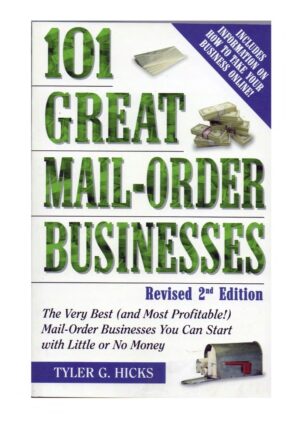Source: The Business Model Analyst / DANIEL PEREIRA
In today’s fast-paced world, generating passive income has become more accessible. Whether you want to create financial security, diversify your income streams, or free up more time, passive income can help you achieve these goals. However, the key to genuinely passive income lies in automation. By leveraging automation, you can set up a business with minimal involvement, earning money even while you sleep.
This article will explore some of the best-automated business ideas for passive income stream. These ideas take advantage of tools and systems designed to streamline tasks, letting you focus less on the day-to-day and more on scaling your efforts or enjoying the benefits of your hard work.
What is Automated Business?
An automated business is a system or process that requires minimal hands-on involvement once set up. Through the use of technology, software, or outsourced services, many of the daily tasks that traditionally require manual effort can be handled automatically. This allows the business owner to focus on strategic growth or even step back entirely while generating income.
Automation can apply to various aspects of a business, such as marketing, sales, customer service, and product fulfillment. For example, email marketing can be automated with scheduled messages, while e-commerce platforms can automate inventory management and shipping. Automation aims to reduce the time spent on repetitive tasks, ensuring that your business runs efficiently even when you’re not actively managing it.
The key to success in an automated business lies in setting up systems that perform consistently and reliably without constant oversight. This makes it ideal for passive income — once the systems are in place, they work for you, freeing up time and energy for other pursuits while still generating revenue.
Benefits of Automation
Automation offers numerous advantages, especially when running a business designed for passive income. By automating key processes, business owners can enjoy more freedom while ensuring consistent performance and profitability. Here are some of the main benefits of automation:
- Time-Saving: One of the most significant benefits of automation is the time it saves. Routine tasks, such as sending emails, processing payments, or managing inventory, can be handled by automated systems without manual intervention. This frees up valuable time, allowing you to focus on scaling your business, exploring new opportunities, or enjoying more personal freedom;
- Scalability: Automation allows businesses to scale quickly and efficiently. Whether you have ten customers or ten thousand, automated systems can handle increased demand without additional resources. For example, an automated online store can process orders, update inventory, and manage shipping for many customers simultaneously, making it easier to grow without being limited by manpower;
- Consistency and Accuracy: Human error is a common challenge in manual processes, but automation ensures consistency and accuracy. Automated systems follow precise rules and perform tasks reliably, reducing the likelihood of mistakes. This is particularly valuable in customer service or payment processing, where accuracy is essential to maintaining customer trust and satisfaction;
- Cost-Effectiveness: While automation may require an initial investment in software or tools, it can save significant costs in the long run. You can lower operational expenses by reducing the need for a large staff or outsourcing repetitive tasks. Automation also allows businesses to run more efficiently, increasing profitability over time;
- Remote Management: One of the most significant advantages of automation is managing your business from anywhere. Automated systems operate 24/7, allowing you to monitor and control various aspects of your business without being physically present. Whether you’re on vacation or focusing on other projects, your business continues to run and generate income.
-

K-31 : The IWS How to Build Riches in Real Estate With Single-Family Homes Using Other People’s Money Wealth Kit
$160.00Select options This product has multiple variants. The options may be chosen on the product page -
Sale!

IWS-27 : The IWS Directory of Fortune 1000 U.S. Companies and Fortune 500 Global Companies
Original price was: $16.00.$4.00Current price is: $4.00.Select options This product has multiple variants. The options may be chosen on the product page -

K-8 : The IWS Raising Money from Grants and Other Sources Success Kit
$120.00Select options This product has multiple variants. The options may be chosen on the product page -

IWS-73 : 203 Home-Based Businesses that Will Make You Rich
$16.00Select options This product has multiple variants. The options may be chosen on the product page
Top 10 Best Automated Business Ideas for Passive Income
1. Dropshipping Business
Dropshipping is an e-commerce model that allows entrepreneurs to sell products online without managing inventory. Essentially, you partner with suppliers who take care of storage, shipping, and returns, allowing you to focus on marketing and growing your customer base.
When a customer places an order on your online store, you purchase the product from a third-party supplier, who then ships it directly to the customer. This means you never have to handle the physical product, making it a low-risk option for starting a business.

One critical advantage of dropshipping is the low upfront investment required. Since you don’t have to purchase inventory beforehand, you can start your business with minimal capital.
You only buy products as orders come in, which helps to mitigate financial risks associated with unsold stock. In addition, dropshipping companies can easily be managed from anywhere in the world with an internet connection, making it an appealing option for those seeking location independence.
However, it’s essential to choose the right niche and reliable suppliers. While the barriers to entry are low, this business model can be highly competitive, especially in popular categories. Researching market trends and targeting specific niches can give you a competitive edge.
Tools like Google Trends, keyword research tools, and social media insights can help you identify in-demand products that will attract customers. As you grow, consider investing in paid advertising and improving your website’s SEO to drive more organic traffic.
2. Affiliate Marketing
Affiliate marketing is a performance-based marketing strategy where you promote someone else’s products or services and earn a commission for any sales or leads generated through your referral.
This business model can be highly lucrative, as it allows you to monetize your website, blog, or social media channels without the burden of creating your products. Many companies offer affiliate programs, enabling you to choose from a wide range of products that align with your audience’s interests.

To succeed in affiliate marketing, building a platform where your target audience engages with your content is crucial. Quality content is vital — create blog posts, videos, or social media updates that genuinely inform or entertain your audience. Incorporate affiliate links seamlessly within your content, ensuring they feel natural and relevant.
Some successful affiliates communicate with their audience using tools like email marketing and sending newsletters with product recommendations that include their affiliate links. For example, Amazon’s marketing strategy incorporates affiliate marketing as one of its channels.
Because affiliate marketing is primarily based on performance, it offers the potential for passive income. Once your content is out there and gaining traction, you can earn commissions even while you sleep.
However, remember that building credibility and trust with your audience is essential. Always disclose your affiliate relationships and promote only those products or services you genuinely believe will add value to your audience. This integrity will strengthen your brand and encourage repeat visits from your followers.
3. Print on Demand
Print on demand (POD) is a creative business model that allows you to sell custom-designed products such as t-shirts, mugs, and phone cases without investing in inventory upfront. When a customer makes a purchase, the product is printed with your design and shipped directly to them from the supplier.
This means you can start an online store without the risks associated with holding inventory, making it an attractive option for artists, designers, and entrepreneurs looking to capitalize on their creativity.
One of the significant advantages of print-on-demand is its product range and design flexibility. You can create and sell various items, from clothing to home decor, connecting you to multiple audience segments. Setting up your online store has never been more accessible with platforms such as Printful, Redbubble, and Teespring.
These platforms usually have user-friendly interfaces and integrate seamlessly with e-commerce sites like Shopify, Etsy, or WooCommerce, making showcasing and selling your designs simple.
Effective marketing is vital for success in your print-on-demand business. Social media platforms like Instagram, Pinterest, and TikTok can be valuable for reaching potential customers through visually engaging content. Utilizing targeted ads can also help boost visibility and attract buyers who are interested in your niche.
In addition, developing a solid brand identity can enhance the appeal of your products. Think about your target audience’s preferences and create designs that resonate with them. As sales increase, you can continuously experiment with new designs and product offerings to keep your store fresh and engaging.
4. Create an Online Course
Creating an online course is a lucrative opportunity for individuals looking to leverage their expertise and earn passive income. With the rise of e-learning platforms such as Udemy, Teachable, and Skillshare, anyone can transform their knowledge into a structured course.
The first step is to identify a niche subject you are passionate about and proficient in — graphic design, coding, photography, or personal finance. Once you’ve settled on a topic, outline the course structure, breaking it down into modules or lessons that progressively build on each other.
After preparing your course content — videos, worksheets, quizzes, and supplementary materials — you’ll upload it onto an e-learning platform. These platforms handle the technical details, including hosting, payment processing, and student access, allowing you to focus solely on content creation.
To maximize your course’s reach, consider using high-quality video production tools to create engaging lessons. Promotions through social media, email marketing, and collaborations with influencers or other educators can also help to attract students to enroll.
Once your course is live, the beauty of this automated business model is that it can generate income continuously with minimal ongoing effort. You only need to respond to student inquiries, update content occasionally, or provide additional resources as needed.
The initial work in building the course pays off as each new student enrolls, providing you with passive income for years to come. Given the flexibility of online education, you may even consider creating a series of courses, diversifying your income streams, and further establishing yourself as an authority in your field.
-

IWS-34 : The IWS Guide to How to Make a Big Fortune as a Licensing Agent
$24.00Select options This product has multiple variants. The options may be chosen on the product page -

IWS-82 : Magic Mind Secrets for Building Great Riches Fast
$16.00Select options This product has multiple variants. The options may be chosen on the product page -

K-28 : The IWS Real Estate Investment Trusts (REIT) Business Kit
$160.00Select options This product has multiple variants. The options may be chosen on the product page -

IWS-66 : The IWS National Directory of Insurance and Financial Industry Organizations
$24.00Select options This product has multiple variants. The options may be chosen on the product page
5. Develop a Mobile App
The mobile app market continues to thrive, with billions of downloads each year, making app development an enticing business idea for passive income. To embark on this journey, identify a problem many people face or an underserved niche.
Your app could be anything from a fitness tracker to a budgeting tool to a language-learning aid. The key is to ensure that it provides a valuable solution that will attract users and encourage them to download and engage with your app.
Once you have a concept, you can learn app development skills or hire a developer to bring your vision to life. Employing frameworks like Flutter or React Native can accelerate the development process since these allow you to create apps for both iOS and Android.
Once the app is launched in app stores, you can monetize it through various channels — ads, subscription models, or in-app purchases. You can maintain user engagement and encourage ongoing monetization by continually updating and improving the app based on user feedback.
A mobile app’s potential for passive income lies in its ability to generate revenue with negligible ongoing effort after launch. Throughout its lifecycle, your app can earn money even while you sleep, depending on how you’ve decided to monetize it. You might find that the right marketing strategy can help your app go viral, leading to thousands of downloads and significant income.
Automation comes into play through automated ad placements or subscription renewals. Thus, your role can shift primarily to oversight and minor updates, freeing up your time for new projects.
6. YouTube Channel with Ads
Starting a YouTube channel focused on evergreen content is another excellent automated business idea for passive income. Evergreen content refers to videos that remain relevant over time, such as tutorials, product reviews, or educational content.
To begin, brainstorm a list of topics you can confidently cover and have a long-term interest in. For instance, cooking channels featuring timeless recipes or tech channels reviewing gadgets can attract consistent viewership over the years.
Creating high-quality videos is essential for standing out in the crowded YouTube space. Invest in decent recording equipment and editing software to produce professional-looking content. As you publish videos regularly, you will gradually build an audience.
Engaging with your viewers via comments and surveys (polls) can help you learn what content resonates most with them and refine your strategy. Optimization techniques — effectively using keywords, thumbnails, and titles — are crucial for increasing your channel’s search visibility.
Once you reach YouTube’s monetization eligibility criteria, which include a minimum number of subscribers and watch hours (for long-form subscribers and views for short-form), you can enable ad placements in your videos. The longer people watch your content, the more ad revenue you can earn. This model can become a passive income stream as your existing videos gather views.
In addition, leveraging affiliate marketing or sponsorships can further diversify your income. You could create a funnel for generating leads or sales, automating your earnings through well-placed affiliate links in your video descriptions. Over time, as your library grows and your channel is optimized, you’ll find a reliable source of passive income from the videos you’ve already produced.
7. Stock Photography
Visual content is more imperative now than ever. Businesses, bloggers, and marketers constantly seek high-quality images to enhance their online presence and storytelling. You can leverage this demand as a photographer by creating and uploading high-quality stock images to various platforms like Shutterstock, Adobe Stock, and iStock.
The beauty of stock photography is that it allows you to monetize what you love doing: capturing beautiful moments, scenes, and expressions through your camera lens.
Once your photographs are uploaded and approved on these stock websites, they become available for license to a vast audience. Each time someone purchases a license for one of your images, you earn a royalty payment.
This passive income can accumulate quickly, particularly if you have a wide-ranging portfolio that appeals to different niches, such as travel, lifestyle, food, and business-related images. The more photos you have available for purchase, the higher your chances of generating consistent income over time.
To optimize your success in stock photography, focus on creating high-quality, in-demand images that are well-composed and well-lit. Consider trends in content, such as specific color palettes or themes currently popular in digital marketing. In addition, invest time in keywording your submissions effectively — accurate and relevant keywords will make it easier for potential buyers to find your work.
Over time, as you expand your portfolio and develop a presence in the market, stock photography can evolve into a sustainable and enjoyable source of passive income.
-

IWS-64 : The IW$ Guide to Ultimate Credit
Price range: $8.00 through $16.00Select options This product has multiple variants. The options may be chosen on the product page -

IWS-202 : 101 Great Mail-Order Businesses: The Very Best (and Most Profitable!) Mail-Order Businesses You Can Start with Little or No Money
$16.00Select options This product has multiple variants. The options may be chosen on the product page -

IWS-51 : The IWS Quick Guide & Directory to Grant-Making Foundations and Corporations
$16.00Select options This product has multiple variants. The options may be chosen on the product page -

IWS-42 : The IWS Compendium of Rapid Real Estate and Business Loan-Getting Methods
$24.00Select options This product has multiple variants. The options may be chosen on the product page
8. Printables and Digital Downloads
The rise of the digital marketplace has opened up new opportunities for creativity and income generation through printables and digital downloads. Entrepreneurs can create and sell downloadable products like planners, worksheets, checklists, templates, or art prints via Etsy or Gumroad. This business model is tantalizing because it requires little overhead; once your products are created, they can be sold multiple times without additional production costs.
Creating printables involves identifying a niche where your offerings can solve problems or add value to potential customers’ lives. For example, you might design meal planners for busy parents, budgeting sheets for finance enthusiasts, or calendars that help people organize their lives more effectively.
By understanding your target audience and adapting your products to their needs, you can carve out a competitive space in the marketplace. Leverage social media and content marketing to showcase your printables, share related tips, and draw people to your shop.
The best part about this business model is that after you’ve set up your initial list of products, managing and maintaining your shop requires minimal ongoing effort. Once a customer purchases, the digital download process is automated, freeing you from direct involvement in sales transactions.
This means you can continue to generate income while dedicating time to other facets of your work, or even developing new products to expand your offerings. The printables market is driven by constant consumer demand, making it a viable option for those seeking passive income through creativity.
9. Real Estate Crowdfunding
If you’re interested in real estate but want to avoid the complexities of property management, real estate crowdfunding may be an excellent business idea. This innovative approach allows individuals to invest in real estate projects via online crowdfunding platforms like Fundrise, RealtyMogul, and Crowdstreet, enabling you to earn passive income from rental properties or development projects without the burdens of direct ownership.
Typically, real estate crowdfunding platforms offer diversified investment options, ranging from single-family rentals to commercial properties. Pooling your money with other investors allows you to access properties that would otherwise require significant capital to acquire outright.
You can invest in projects that align with your investment goals and risk tolerance. As the properties generate income from rent or appreciation, profits are distributed proportionally to the investors, allowing you to earn passive income with minimal time input.
Thorough research is crucial before diving into real estate crowdfunding. Evaluate different platforms, their track records, fee structures, and the types of properties they invest in. Look for transparent reporting and trustworthy management teams that consistently update project performance.
While real estate investment always carries some risk, crowdfunding allows you to diversify your portfolio, benefit from professional management, and potentially generate passive income over time. This method democratizes access to real estate investments, making it an increasingly popular option for aspiring investors.
10. Self-Publishing E-books
Self-publishing e-books is an increasingly popular avenue for generating passive income, allowing aspiring authors to turn their knowledge or creativity into cash flow. The process generally starts with identifying a niche that interests you — anything from self-help and health to tech tutorials or fiction novels. Conducting market research will help you understand what readers are looking for, which can guide your content and increase its chances of success.
Once you’ve settled on a topic, the next step is writing and formatting your e-book. It’s essential to ensure high-quality content; consider hiring a professional editor. Once the manuscript is polished, you can design an eye-catching cover, often the first thing potential readers will see.
Various tools are available for this, or you can hire a graphic designer to create a professional look that matches your book’s theme. The formatting process also ensures your e-book is compatible with multiple devices, such as Kindle, Apple Books, and Google Play Books.
After your e-book is ready, self-publishing platforms like Amazon Kindle Direct Publishing (KDP), Draft2Digital, or Smashwords make it easy to publish your work. Once your e-book is listed, you can generate passive income through royalties whenever a copy is sold.
Amazon KDP, for example, pays authors between 35% to 70% royalties depending on the pricing and distribution options you choose. You can also use these platforms’ promotional tools, such as Kindle Unlimited or price promotions, to boost visibility and sales.
The beauty of self-publishing is that the work you put in during the initial phases can continue to pay off long after publication. You can drive traffic to your e-book sales page with a well-crafted marketing strategy, including social media promotion, blogging, or even creating an author website.
Additionally, consider leveraging email marketing to reach past and potential readers. With quality content and a solid marketing plan, self-publishing can become a sustainable source of passive income, providing you earn royalties long after the initial work is done.
Conclusion
The opportunities for generating passive income through automated business models vary. Investing time and effort in establishing systems that leverage technology or outsourced services can create sustainable income streams requiring minimal ongoing involvement. From dropshipping and affiliate marketing to print-on-demand and self-publishing, the key lies in choosing the suitable model that aligns with your skills and interests.
As you embark on your journey toward passive income, remember the importance of thorough research, market understanding, and strategic planning. Each automated business idea discussed has unique benefits and challenges, but they all share the potential to provide financial freedom and flexibility.
By automating tasks, you can save time and scale your business operations efficiently, allowing you to focus on what matters most — expanding your existing business, pursuing new ventures, or enjoying your newfound free time.
Remember, the initial setup may require hard work and dedication, but the rewards of creating a well-oiled automated machine can lead to a happier, more balanced life. With determination and the right tools, you can turn your ideas into reality and pave the way for lasting passive income.
Source: The Business Model Analyst / DANIEL PEREIRA
-

IWS-64 : The IW$ Guide to Ultimate Credit
Price range: $8.00 through $16.00Select options This product has multiple variants. The options may be chosen on the product page -

IWS-202 : 101 Great Mail-Order Businesses: The Very Best (and Most Profitable!) Mail-Order Businesses You Can Start with Little or No Money
$16.00Select options This product has multiple variants. The options may be chosen on the product page -

IWS-51 : The IWS Quick Guide & Directory to Grant-Making Foundations and Corporations
$16.00Select options This product has multiple variants. The options may be chosen on the product page -

IWS-42 : The IWS Compendium of Rapid Real Estate and Business Loan-Getting Methods
$24.00Select options This product has multiple variants. The options may be chosen on the product page






Comments on: The Best Businesses You Can Start for Passive Income